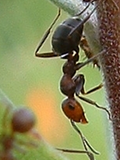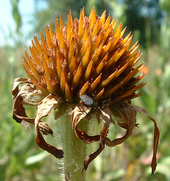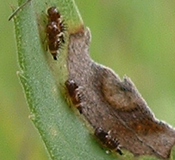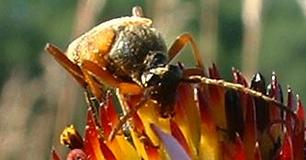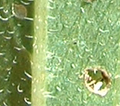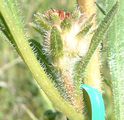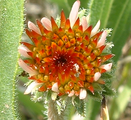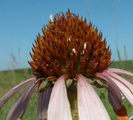Now you can get gallons of organic milk in Alexandria. I thought some of you would be interested
|
||||
CategoriesExperiments
|
It is one of my greatest failures that after four summers in a part of Minnesota where there are more lakes than people I still do not know how to fish. Therefore, this summer when I am not measuring Echinacea I can often be found on a lake trying to learn how to fish. I have been only somewhat successful in this endeavor (as you can see by the picture below). However, with the help of Ian, my dad, and my Kensington friend Clint, I am completely confident that by the end of the summer I will be a mediocre fishing woman. This summer, much more so than in years past, fishing has been a major pastime for a number of the field crew when we are not learning the wonders of Echinacea. Overall I contribute the increase in fishing to two major factors; one living at Andes where we have access to a row boat on a lake full of fish, and, more importantly, actually having crew members that can tie fishing line on hooks (before last week this was not me). Below I have included just a few pictures of our fishing excursions. However, for the entire 112 fishing pictures (most thanks to Ian) see my piacasa web album at http://picasaweb.google.com/ison.jennifer/FishingInMinnesota Lake Isaac Jennifer Ison | August 2nd, 2007 | Category: stories from the field | One comment We were enjoying a delicious supper of curried chick peas and green beans in the RAJ mahal, relaxing in spite of the raucous shrieking of a gaggle of pre-adolescents in our usually peaceful backyard (e.g. the alpine glory that is Andes Ski Hill). We heard the tweens erupt into rapturous cheering and looked out the window in time to see Ian emerge over the crest of the mountain on his bike, reminiscent of Gandalf, back lit by the morning sun, boldly perched atop Shadowfax. After bombing down the black diamond, Ian cruised back to the mando with a hoard of teenyboppers hot in pursuit. In the throes ecstasy, celebrating their newfound hero, the aggregation of blond children called out eager questions to this mysterious stranger: ‘Where are you from?’ ‘What’s your name?’ and yes, even, ‘can I have your autograph?’ Julie Nichol | August 2nd, 2007 | Category: stories from the field | Leave a comment With the influx of work related postings, I thought I would shed some light on the day to day goings-on of the Andes’ condos. Specifically, I will cover the activities of the 3-bedroom-condo, fondly dubbed “The Mando” (though it is now slightly inaccurate as Jennifer has been living here for several weeks now). I exclude the 2-bedroom-condo, fondly named the Raj-Mahal, not out of spite or ill-will but rather because they’re crazy and I don’t know what they do all day. Colin Venner | August 1st, 2007 | Category: stories from the field | Leave a comment There may be a sudden influx of blog entries very soon because when we don’t work, we get to flog. I was out at Hegg Lake when the storm rolled in today around 11. Jennifer heard the thunder and told us to finish our row and then we would consider our options. Before we could finish our rows, Jennifer looked up, noticed the clouds and thunder were almost overhead and said we should go back to the farmhouse. Everyone else was already in the farmhouse at that point because it was pouring and there was lightning, so they decided to scamper inside. Some pictures from today: Here’s a photo of the measurers and datatakers at the Hegg Lake common Garden on July 26th. The weather for measuring turned out to be much nicer than predicted: Temp 85 degrees F; dewpoint: 70 degrees F; mostly cloudy with a W wind at 13 mph. It started raining, so we packed up to leave. As we were walking out the rain stopped, so we paused to take this photo. After the photo, it started to rain again. We measured plants efficiently. Most plants have two leaves and the longest is 8-19 cm tall. It can be very difficult to find a plant because the thick grass is about 50 cm high. The only way to find it is to measure from another Echinacea plant. The ~4000 plants are spaced on 1m apart on a 80m x 50m grid. That can seem like a vast distance between plants. Jennifer made measuring sticks 2 meters long to help us stay on line and find the plants. After finding two plants you could keep on line fairly well and go fast. If there was a missing plant or a particularly sneaky plant, then it was very easy to get disoriented. Some folks worked in pairs (one measuring, one taking data); others solo. Here’s a photos of folks at work… Stuart Wagenius | July 27th, 2007 | Tags: measuring | Category: Heritability of flowering time, stories from the field | One comment i started this flog entry last year and never finished it. I’m just going to publish it as it is… To streamline the process and get everyone on the same page i’m compiling photographs of all the different categories that we are noting in association with Echinacea plants. Status Insects grasshopper leaf miner ???????????? Disease deformed lf dead lf Wrinkles 1 lf minor Other Damage 1 lf minor 1 mowed lf 1 burned tip CGhead-info-07sub no fls normal ants ant nest egg sac wht fuzzy long-legged bug larva beetle pupa thorn hopper spittle grasshopper
Insect Damage Disease (head) whole hd weird weird tufts At last, after car trouble aborted my trip last week, I made it back out to Douglas County to join in field work with Team Echinacea. What a difference from the 2 days in late May, when Stuart, Jennifer, Andrea, Amy Mueller, and I were there searching for seedlings in the remnants! On Wed, the team numbered 12, and we made great headway measuring plants in the common garden. We were undaunted by the heat and humidity, though we did welcome every breeze. Today, we had the benefit of clouds all morning, and 13 of us measured quite a few plants at the Hegg Lake experimental site before rain, which we’d been seeing in the distance all morning, chased us in for lunch. The weather canceled field work for the afternoon, but we received instruction from Rachel about the upcoming work to evaluate species composition at her research sites, and I conferred with Stuart on analysis of pollinator visitation data before I headed back to the Twin Cities. I enjoyed the opportunity to meet the new members of the crew and working with them and look forward to the next time. Ruth Shaw | July 26th, 2007 | Tags: measuring | Category: Common garden experiment, Heritability of flowering time, stories from the field | Leave a comment Hi all, We have spent a large part of the last week I have been here measuring both in the common garden and at the hegg lake common garden. The hegg lake common garden was established back in May of 2006 to as part of my graduate research. It is about 6 miles from the main common garden on Minnesota DNR land. It has around 4,000 plants planted on a 1m X 1m grid. Today we had the entire field crew out at hegg lake measuring for a total of 13 people and measured nearly half of the entire plot just today…it was great! Besides the field work I have been keeping myself busy in rural Minnesota by fishing (Ian has promised that I will actually know how to fish by the end of the summer), playing poker, and going to a dirt track race. In the near future I plan on flogging all non-Echinacea related activities that can be done in rural Minnesota….however now I’m tired so it will have to wait until the weekend. Jennifer Ison | July 26th, 2007 | Tags: measuring | Category: Common garden experiment, Flowering phenology in experimental plots, Heritability of flowering time, stories from the field | Leave a comment For my most recent blog entry I’ve made a video. It is what I believe to be a Bembix wasp digging a nest. I filmed it on the backside of the Andes hill in a really dry and sandy area. I edited it down a lot. Originally there were about 24 minutes of video, but I cut a lot of the digging out as well as time in which the bee was not visible. The link for the video is http://www.youtube.com/watch?v=wskx8EKbeo0 . Make sure to have speakers on for it, but if the music isn’t your thing and you simply want to bask in the quiet glory of the wasp, watch it without sound. Ian Grettenberger | July 26th, 2007 | Category: stories from the field | Leave a comment |
Recent PostsArchives |
||
|
© 2024 The Echinacea Project - All Rights Reserved - Log in Powered by WordPress & Atahualpa |
||||



